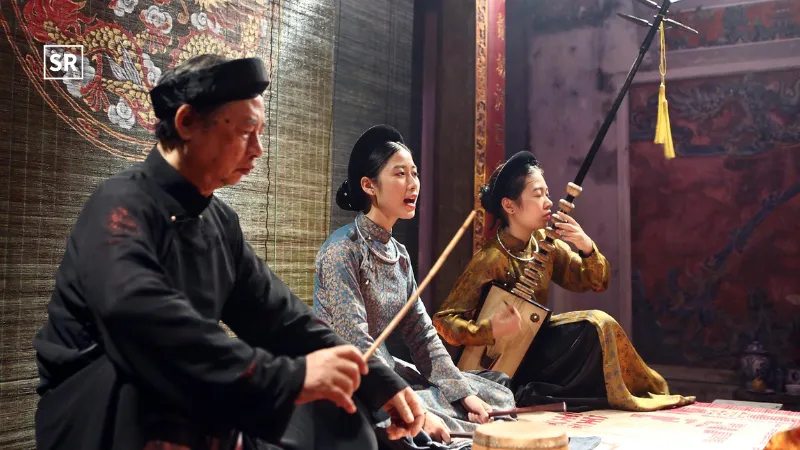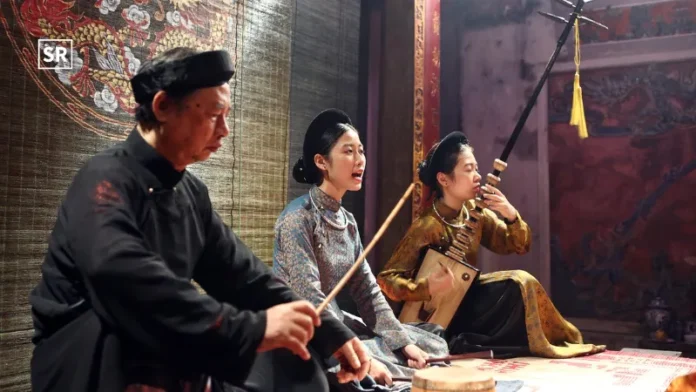
Ca Trù is a traditional Vietnamese art form that has been around for many centuries. It is unique and plays an important role in Vietnam’s music and culture. This form of singing is closely connected with festivals, traditions, beliefs, literature, and the way Vietnamese people view life.
No one knows exactly when Ca Trù first started, but it is known that it became very popular in the 15th century. Over time, it developed into an important part of community and cultural events.
In the past, Ca Trù was mainly performed by guilds—groups of trained singers. People enjoyed Ca Trù in many places such as village communal houses, temples, ancestral halls, wealthy families’ homes, and special singing houses.
Ca Trù added beauty to village gatherings and intellectual activities. It was also used by the royal court during important ceremonies and diplomatic events. This shows how deeply respected and meaningful Ca Trù was in Vietnamese society.
Hát Ca Trù
Hát Ca Trù is an old and special style of Vietnamese singing that has been loved for many years. It is known for its soft, gentle music and meaningful words. A Ca Trù performance usually has three people: a female singer with a beautiful, clear voice, a musician playing a long instrument called the đàn đáy, and another performer who makes rhythm using wooden or bamboo clappers.
The music in Ca Trù is slow, smooth, and full of emotion, so listeners often focus closely on every sound. Performances usually happen in quiet places like temples, communal houses, or traditional singing rooms. These calm settings make it easy for people to enjoy the beauty of the music without distractions.
Ca Trù has been an important part of Vietnamese culture for a long time, especially for poets and educated communities. Even though it is an ancient art form, many people still learn and perform it today to protect its unique beauty and make sure future generations can enjoy it too.
Song ca trữ tình
Song ca trữ tình is a type of Vietnamese duet singing where a man and a woman usually perform together. The songs are gentle, emotional, and often talk about love, memories, or life’s beautiful moments. The melodies are smooth and easy on the ears, making the music very enjoyable.
When the two voices come together, the songs feel more touching and full of warmth. The harmonies create a relaxing and emotional experience for listeners. This makes song ca trữ tình music feel comforting and deeply moving.
This singing style is often performed at concerts, on TV, on stage, and even at family gatherings. People of all ages like it because the tunes are simple to follow and the lyrics are heartfelt. Over time, song ca trữ tình has become one of the most popular and cherished forms of Vietnamese music.
Revival of Ca Tru
On February 23, 2020, Google honored Ca Tru, a traditional Vietnamese music form, with a special Google Doodle. The illustration showed three Ca Tru performers sitting on a flower mat, highlighting this unique and historic art.
Ca Tru is a traditional music style that was once highly respected in Vietnam. It started as entertainment for the royal aristocracy in the palace and later became popular among the people of Hanoi.
Preserving Ca Tru is difficult because it was traditionally taught orally and kept secret by the artists. However, in recent years, the art has seen a revival thanks to efforts from government organizations and international agencies.
Recent surveys show that Ca Tru has recovered well in many areas of Vietnam. In 2010, there were about 63 Ca Tru clubs with around 769 performers, including 513 female singers and 256 male singers and drum players. These clubs now operate regularly and have organized training programs to pass the art to the next generations.
The Vietnam National Institute of Music is keeping important materials related to Ca Tru. This includes 7 Ca Tru dances, 42 Ca Tru songs, 26 Han Nom documents, and around 25 books about Ca Tru.
These materials are very valuable for research and help authorities and scholars preserve and develop the Ca Tru tradition for future generations.
Conclusion
In conclusion, Ca Trù and song ca trữ tình are important parts of Vietnam’s rich and unique musical tradition. These art forms are more than just songs—they show the culture, history, and values of the Vietnamese people. Ca Trù, with its soft melodies, meaningful lyrics, and detailed performances, has been loved for hundreds of years and has played a key role in village life, among scholars, and even in royal ceremonies. Song ca trữ tình, with its emotional duets and blended voices, continues to move listeners and remains a popular part of Vietnamese music today.
Thanks to the dedication of cultural organizations, researchers, and initiatives like Google Doodles, these traditional music forms are being preserved and shared with new generations. Through training programs, active clubs, and carefully collected records, both Ca Trù and song ca trữ tình have experienced a strong revival, making sure their beauty and cultural value are not lost. Today, they connect Vietnam’s past with the present, allowing people of all ages to enjoy and learn about the country’s musical heritage. By performing, listening, and appreciating these songs, Vietnamese culture stays alive and continues to inspire, keeping the lasting charm of Ca Trù and song ca trữ tình for years to come.
FAQs
What is Ca Trù?
Ca Trù is a traditional Vietnamese singing art that has been around for centuries. It features a female singer, a đàn đáy (long-necked lute) player, and a percussionist using clappers. The music is gentle, emotional, and usually performed in quiet, intimate settings.
Where is Ca Trù performed?
Ca Trù is typically performed in traditional spaces like temples, communal houses, or old-style singing rooms. It was also historically performed in royal courts and mansions.
Where can I hear Song Ca Trữ Tình?
Song Ca Trữ Tình is commonly performed at concerts, on TV shows, on stage, or even at family gatherings. It is enjoyed by people of all ages.





